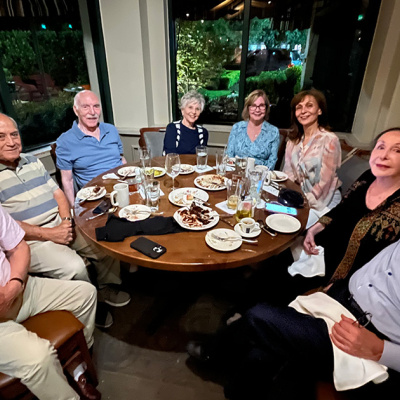TXEXplainer: Next Steps for the Dell Medical School
At the first open forum organized around the coming Dell Medical School, the public got a good look at how the new medical school is shaping up.

Last night, the long-awaited Dell Medical School finally opened its doors—metaphorically, at least. At a crowded public forum, officials from UT, the Seton Healthcare Family, and Travis County's health care authority, Central Health, put forward plans not only to create a new medical school and teaching hospital, but instead for an entire medical district. It's an ambitious plan meant to transform the way health care is delivered in Central Texas.
On screen, a graphic represented the partners attempting to build the district as five interlocking puzzle pieces—an apt metaphor for a very complicated and nuanced mission, one that will cost hundreds of millions of dollars and potentially make health care more accessible and more preventative in Central Texas.
And they have to do it quickly. From laying concrete and hiring builders, to getting accredited and hiring a dean, the project has lots of boxes to check—and only a few years to do so. The first medical students are expected to arrive in Austin in 2016, and the new teaching hospital is set to be completed in 2017. These are a few of the changes coming soon:
Red River Street is getting realigned—and a lot more. In order to execute the plan, curvy Red River Street will get straightened out north of 15th Street to facilitate new buildings. That area should be completed within a year, while parts of the street farther south will be closed on-and-off from 2016-19. UT estimates the medical district project will cost $430.5 million. Seton will begin constructing the new hospital in 2014, and will finish in 2017.
Between then and now, construction concerns are rampant in the area bounded by Trinity, Red River, 15th Street, and IH-35. Architects will have to consider the floodplain, Waller Creek, and 40 different sightlines to the state capitol, all with a tight schedule and tight budget.
Out with the old, in with the new. UT vice president for university operations, Pat Clubb, was frank. Eventually, she said, the 40 year-old Erwin Center will have to go. But that's a much later part of the University's master plan.
For now, she explained, the focus is on building four new UT buildings and a new power station, while Seton is focusing on their $295-million dollar hospital, which will be about that same size as the current University Medical Center Brackenridge. That building's fate is still unknown. In February, UT expects to go to the UT System Board of Directors for final approval for its plans.
"We are on schedule," Clubb said, "and we'll stay on schedule."
UT has to lay the academic foundation. In order to welcome its first group of students, UT has to earn three different accreditations, one from the Texas Higher Education Coordinating Board, which has already given preliminary approval; one from the Southern Association of Colleges and Schools; and one from the national Liaison Committee on Medical Education. That organization is already facing the challenge of accrediting 17 other new medical schools around the country.
The University also has to solidify a curriculum and name a dean. Interim dean Sue Cox explained that a full medical curriculum is being developed, focusing on interdisciplinary research, administrative best practices, and early clinical training. She also indicated that dean candidates have been contacted, but didn't elaborate. Former provost Steven Leslie, however, said that the new dean could be announced as early as January. Leslie currently serves as special assistant to UT president Bill Powers for medical education.
The goal is to transform care. It took about 15 minutes before a variant of the word synergy was used (it was "synergistic," for the record), which honestly seemed like a long time, considering how much talk of collaboration and transformation there was and has been in planning the new school.
Central Health president Patricia Young Brown, as well as Seton external affairs president Greg Hartman, BA '83, touted what Hartman called an "amazing amount of collaboration" between, the University, Seton, Central Health, and that fifth puzzle piece, the community. Hartman noted that the public's endorsement of better care through Prop 1 catalyzed the partners, and Brown noted that the Prop 1 property tax increase secured a huge federal grant to help create more accessible health centers and keep people out of emergency rooms.
At the beginning of the evening, state Sen. Kirk Watson (D-Austin) opened with a simple rhetorical question about the school and medical district: "What's in it for Austin, Texas?"
Watson's answer, echoed by the panelists, sounded simple, but in practice is incredibly complex. Austin, he said, will get better care, more clinics, a new hospital with more mental health space, physicians to fight a regional shortage, and "next-generation health care."
That, and more traffic headaches, of course. At least for the foreseeable future.
Photo courtesy Marsha Miller.
Listen to our UT Advocates podcast with Seton president for external affairs Greg Hartman here. You can subscribe to the UT Advocates podcast on iTunes.
Learn more about Texas Exes advocacy efforts here.
You can become a UT Advocate here, or sign up for advocacy emails here.






